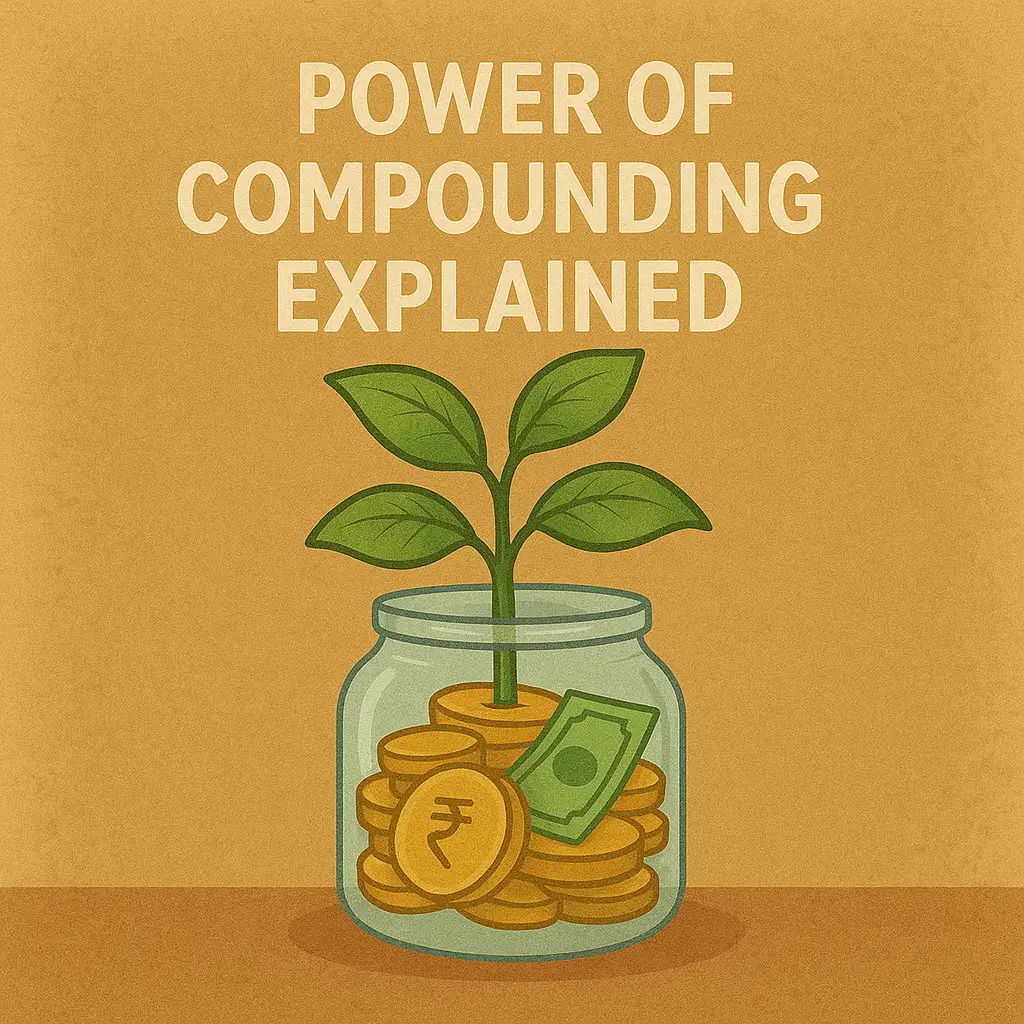
Albert Einstein once reportedly said:
“Compounding is the eighth wonder of the world. He who understands it, earns it. He who doesn’t, pays it.”
Whether or not Einstein actually said it, the principle of compound growth is undeniably one of the most powerful forces in personal finance.
In this article, we’ll explain:
- What compounding means (in real-world terms)
- How it works with examples
- Why starting early matters more than investing more
- Mistakes people make that kill compounding
- How to make it work for your long-term wealth
Section 1: What Is Compounding?
Compounding is the process where your earnings generate more earnings over time. It’s often called “interest on interest.”
Let’s simplify this:
Imagine you invest ₹10,000 in a fund that gives 10% annual return.
- After 1 year: ₹10,000 → ₹11,000 (₹1,000 earned)
- After 2 years: ₹11,000 → ₹12,100 (₹1,100 earned)
Notice how your second-year return is more than the first? That’s because you earned 10% on ₹11,000, not just the original ₹10,000.
As this continues, your money begins to snowball.
Section 2: The Formula Behind Compounding
To calculate compound interest:
FV = PV × (1 + r)^n
Where:
- FV = Future Value
- PV = Present Value (initial investment)
- r = annual rate of return
- n = number of years
Example:
₹50,000 at 12% for 10 years
→ FV = 50,000 × (1.12)^10 = ₹1,55,530
Your investment triples in just 10 years.
Section 3: Visualizing Compounding with a Table
Let’s say you invest ₹5,000/month for 20 years at 12% return. Here’s what it looks like:
| Year | Amount Invested | Interest Earned | Total Value |
|---|---|---|---|
| 5 | ₹3 lakh | ₹1.1 lakh | ₹4.1 lakh |
| 10 | ₹6 lakh | ₹5.1 lakh | ₹11.1 lakh |
| 15 | ₹9 lakh | ₹13.5 lakh | ₹22.5 lakh |
| 20 | ₹12 lakh | ₹28.6 lakh | ₹40.6 lakh |
By year 20, your investment more than triples — not because you increased your input, but because of time.
Section 4: Why Starting Early Matters More Than Investing More
Meet Asha and Ravi:
- Asha starts investing ₹5,000/month at age 25 and stops at 35 (invests for 10 years).
- Ravi starts at age 35 and continues till 60 (invests for 25 years).
At 12% return:
- Asha’s total investment = ₹6 lakh → Grows to ₹95 lakh by 60
- Ravi’s total investment = ₹15 lakh → Grows to ₹76 lakh by 60
Conclusion: Asha invests less for a shorter time — but earns more, because she started earlier and gave compounding time to work.
Section 5: The Rule of 72
Want a quick hack to estimate how long it’ll take your money to double?
72 ÷ interest rate = years to double
At 12% → 72 ÷ 12 = 6 years
So ₹1 lakh today becomes:
- ₹2 lakh in 6 years
- ₹4 lakh in 12 years
- ₹8 lakh in 18 years
No extra effort. Just time + patience.
Section 6: Where Can You See Compounding in Action?
1. SIP in Mutual Funds
Regular monthly investments grow significantly over time.
2. PF and PPF Accounts
Government retirement schemes compound yearly.
3. FDs and RDs
Banks compound quarterly or annually.
4. Stocks with Dividends Reinvested
You earn returns on both stock value and dividends.
Section 7: Real-World Indian Example: SIP in Action
Suppose you invest ₹10,000/month in a mutual fund with 12% CAGR:
| Duration | Investment | Value at End |
|---|---|---|
| 10 years | ₹12 lakh | ₹23.3 lakh |
| 20 years | ₹24 lakh | ₹99 lakh |
| 30 years | ₹36 lakh | ₹3.5 crore |
Just ₹10k/month can potentially make you a crorepati, without needing to take big risks — just consistent investing and time.
Section 8: Factors That Boost Compounding
✅ 1. Time
The longer you stay invested, the stronger compounding gets.
✅ 2. Rate of Return
Higher returns boost results — but don’t chase unrealistic returns. Focus on consistent, average growth.
✅ 3. Reinvestment
Always reinvest interest, dividends, or capital gains instead of withdrawing them.
✅ 4. Frequency
Monthly compounding > annual compounding.
Section 9: Common Mistakes That Kill Compounding
❌ Starting Late
Even a 5-year delay can cut your corpus by half.
❌ Withdrawing Too Early
Breaks the compounding cycle. Keep emergency funds separate.
❌ Not Increasing Investments
As income grows, your SIP should too.
❌ Chasing Hot Stocks
Frequent switching disturbs compounding flow.
Section 10: Compounding Isn’t Just for Money
You can apply the same principle in life:
- Learning: 1% better every day = 37x better in a year
- Health: Small daily habits → major transformation
- Relationships: Regular check-ins strengthen bonds
- Career: Regular skill-building = exponential growth
Section 11: Compounding vs Simple Interest
Let’s compare:
| Metric | Simple Interest | Compound Interest |
|---|---|---|
| Interest on | Principal only | Principal + accumulated |
| Growth | Linear | Exponential |
| Example (₹1 lakh @10% for 5 years) | ₹1.5 lakh | ₹1.61 lakh |
That’s a difference of ₹11,000 in 5 years. Stretch it to 20 years and the difference becomes massive.
Section 12: Tips to Maximize Compounding
✅ Start EARLY (even with ₹500/month)
✅ Avoid frequent withdrawals
✅ Automate your SIPs
✅ Review investments once a year
✅ Increase contributions annually
✅ Think long-term, not day-to-day
Section 13: Psychological Barrier: Why People Don’t Use Compounding
Most people:
- Underestimate what consistent effort can do
- Want quick rewards
- Don’t see results in the first few years
But compounding is slow at first, then suddenly explosive.
Like bamboo — it stays underground for years, then shoots up 90 feet in 6 weeks.
Section 14: The Hockey Stick Growth Curve
In early years, compounding growth is modest. Then suddenly, it takes off.
The last few years of a long-term investment often contribute more than the first 10 years combined.
So don’t stop the ride early.
Section 15: Case Study: From Clerk to Crorepati
Rajesh, a government clerk, started investing ₹2,000/month in a mutual fund in 1995.
He never increased the amount, never withdrew.
In 2023, he retired with over ₹2 crore — all from compounding.
Conclusion: Let Time Be Your Ally
The beauty of compounding is that you don’t need to be rich to become rich.
You just need:
- Time
- Consistency
- Patience
Whether you’re 18 or 38, the best time to start is now. Even small amounts invested consistently can grow into life-changing wealth — thanks to the magic of compounding.
In a world obsessed with speed and shortcuts, compounding rewards the slow, the steady, and the disciplined.
Let your money — and your habits — grow silently in the background.
That’s real financial power.


